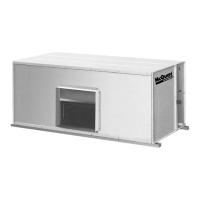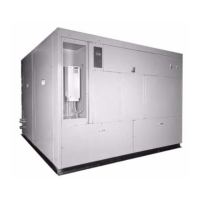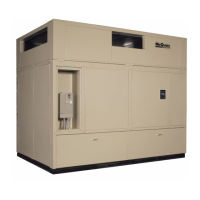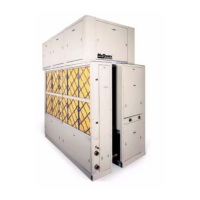Trouble Shooting Chart
PROBLEM POSSIBLE CAUSES
POSSIBLE CORRECTIVE STEPS
1. Main switch open.
1.
Close switch.
2. Fuse blown. Circuit breakers open.
2. Check electrical circuits and motor winding for shorts
or grounds. Investigate for possible overloading. Re-
place fuse or reset breakers after fault is corrected.
3. Thermal overloads tripped.
3. Overloads are auto. reset. Check unit closely when
Compressor will
unit comes back on
line.
not run
4. Defective contactor or coil. 4. Repair or replace.
5. System shut down by safety devices.
5. Determine type and cause of shutdown and correct it
before resetting safety switch.
6. No cooling required.
6. None. Wait until unit calls for
cooling.
7. Liquid line solenoid will not open. 7. Repair or replace coil.
8. Motor electrical trouble 8. Check motor for opens, short circuit, or burn out.
9. Loose wiring.
9. Check all wire junctions, Tighten all terminal screws.
I.
Flooding of refrrgerant Into crankcase. 1. Check setting of expansion valve.
Compressor noisy 2. Improper piping support on suction or 2. Relocate, add or remove hangers.
or vibrating liquid line.
3. Worn compressor
3. Replace.
1.
Non-condensibles in system.
I.
Purge the non-condensibles.
High Discharge
2. System overcharged with refrigerant.
2. Remove excess.
Pressure
3. Discharge shut off valve partially closed.
3. Open valve.
4. Seasontrol out of adjustment 4. Adjust Seasontrot valves.
5. Fan not running.
5. Check belts and electrical
crrcuit.
I.
Faulty condenser temperature regulation.
I.
Check condenser control operation.
2. Suction shut-off valve partially closed.
2. Open valve.
Low Discharge
3. insufficient refrrgerant in system.
3. Check for leaks. Repair and add charge.
Pressure
4. Low suction pressure.
4. See Corrective Steps for low suction pressure below.
5. Compressor operating unloaded. 5. See Corrective Steps for failure of compressor to load
up below.
1. Excessive load.
1.
Reduce load or add additional equipment.
High Suction 2.
Expansron
valve
overfeedrng.
2. Check remote bulb. Regulate superheat.
Pressure
3. Compressor unloaders open.
3. See Corrective Steps below for failure of compressor
to load up.
1. Lack of refrigerant.
1.
Check for leaks. Repair and add charge.
2. Evaporator dirty. Plugged
acr
filters.
2. Clean
chemrcally.
3. Clogged
liqurd
lrne
filterdrier.
3. Replace cartridge(s).
Low Suction
4. Clogged suction line or compressor suction. 4. Clean
strarners.
Pressure
gas strainers.
5. Expansion valve malfunctioning.
5. Check and reset for proper superheat.
6. Condensing temperature too low.
6. Check means for regulating condensing temperature.
7. Compressor will not unload. 7. See
Correctrve Steps for failure of compressor to
unload.
Compressor will not 1. Defective
capacrty
control.
I.
Replace.
unload or load up. 2. Pressurestat not set for application. 2. Reset pressurestat setting to fit applicatron.
1. Clogged suction oil strainer.
1. Clean.
2. Excessive liquid
rn
crankcase.
2. Check crankcase heater. Reset expansion valve for
higher superheat. Check liquid line solenoid valve
operation.
3. Oil pressure gauge defective.
3. Repair or replace. Keep valve closed except when
taking readings.
Little or no oil
4. Low oil pressure safety switch defective.
4. Replace.
pressure
5. Worn
011
pump.
5. Replace.
6. Oil pump reversing gear stuck in wrong
6. Reverse
drrectron
of compressor rotation.
position.
7. Worn
bearrngs.
7. Replace compressor.
8. Low oil level.
8. Add oil.
9. Loose fitting on oil lines.
9. Check and tighten system.
10. Pump housing gasket leaks.
10. Replace gasket.
11. Flooding of refrigerant into crankcase.
11. Adjust thermal expansion valve.
Compressor loses
1. Lack of refrrgerant.
1.
Check for leaks and repair Add refrigerant.
oil
2. Excessive compression ring blow-by.
2. Replace compressor.
1. Low voltage during high load conditions.
1. Check supply voltage for excessive
lrne
drip.
2. Defective or grounded wring in motor.
2. Replace compressor motor.
3. Loose power wiring.
Motor overload
3. Check all connections and tighten.
4. High
condensrng
temperature.
4. See Corrective Steps for high discharge pressure.
relays or circuit
5. Power line fault causing unbalanced voltage.
5. Check supply voltage. Notify power compnay. Do not
breakers open
start until fault is corrected.
6. High ambient temperature around the
over-
6. Provide ventilation to reduce heat.
load relay.
7. Failure of second starter to pull in on
part-
7. Repair or replace starter or time delay mechanism.
winding start systems.
Compressor thermal
protector switch
open.
1. Operating beyond design conditions.
2. Discharge valve partially shut.
3. Blown valve plate gasket.
I. Add facilities so that conditions are within allowable
limits.
2. Open valve.
3. Replace gasket.
page 42

